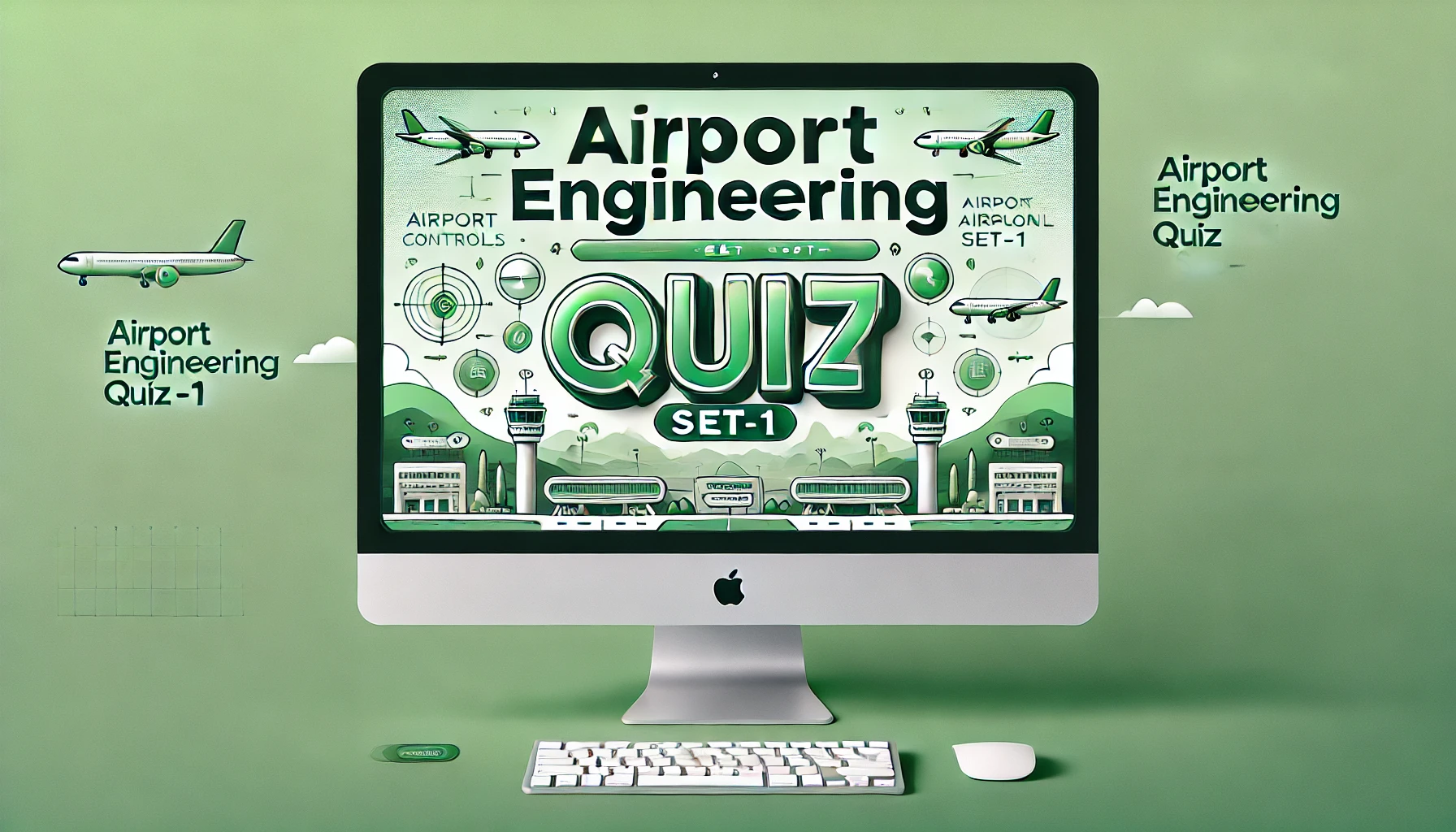Airport Engineering Quiz Set-1 [2025]
Welcome to “Airport Engineering Quiz Set-1 [2025]”! In this blog, we’ve curated 50+ thought-provoking multiple-choice questions covering the fundamental and advanced concepts of airport engineering. “Airport Engineering Quiz Set-1 [2025]” is designed to help you refresh your basics, challenge your knowledge, and gain practical insights into the principles and practices of airport design and operations. Whether you’re a civil engineering student, an airport planning professional, or preparing for competitive exams, this quiz is the perfect way to enhance your expertise in airport engineering. Let’s dive into the “Airport Engineering Quiz Set-1 [2025]” and start exploring! Airport Engineering: The Backbone of Modern Aviation Introduction Airport engineering is a specialized branch of civil engineering that focuses on the design, construction, and maintenance of airports and their infrastructure. As global aviation continues to expand, airport engineering plays a pivotal role in ensuring safe, efficient, and sustainable air travel. From runways to terminals, every aspect of an airport requires meticulous planning, design, and execution. This blog explores the fundamentals, applications, challenges, and future trends of airport engineering. What is Airport Engineering? Airport engineering involves the planning, design, construction, and maintenance of airport facilities, including runways, taxiways, aprons, terminals, parking areas, air traffic control towers, and support systems. It ensures that airports meet the standards set by aviation authorities such as ICAO (International Civil Aviation Organization) and FAA (Federal Aviation Administration). Airport engineering also considers factors such as passenger traffic, aircraft types, weather conditions, and safety regulations. It combines technical expertise with a thorough understanding of aviation operations. See Also: Steel Structures Quiz Set-1 Key Components of Airport Engineering Runway Design Runways are the most critical part of an airport. Their orientation, length, and surface type depend on factors like wind patterns, aircraft size, and geographic location. Engineers calculate the Pavement Classification Number (PCN) to ensure the runway can handle specific aircraft loads. Taxiways and Aprons Taxiways connect runways to terminals and parking areas. Their design focuses on minimizing aircraft taxi times and ensuring smooth operations. Aprons are areas where aircraft are parked for boarding, loading, fueling, and maintenance. Terminal Buildings Terminals are designed to handle passenger flow efficiently while providing amenities such as lounges, check-in counters, baggage claim, and security checks. Sustainable design features, like energy-efficient HVAC systems and solar panels, are increasingly incorporated. Air Traffic Control (ATC) ATC towers manage aircraft movements on the ground and in the airspace around airports. Engineers design these facilities to provide clear visibility and advanced communication systems. Airport Drainage Systems Effective drainage systems prevent waterlogging on runways and taxiways, ensuring operational safety during heavy rainfall. Lighting and Signage Runway and taxiway lighting systems guide pilots during low-visibility conditions. Signage ensures seamless navigation for both aircraft and passengers. Support Facilities Cargo terminals, fire stations, maintenance hangars, and fuel depots are essential components of an airport. Challenges in Airport Engineering Land Acquisition Acquiring large tracts of land for airport construction can be challenging due to legal, environmental, and social factors. Environmental Impact Airports contribute to noise pollution, air pollution, and habitat disruption. Engineers must incorporate mitigation measures like sound barriers and green spaces. Capacity Management As air traffic grows, airports face challenges in managing passenger and cargo volumes efficiently. Expanding facilities without disrupting operations is a complex task. Safety Standards Meeting strict safety standards for runways, taxiways, and other facilities is a continuous challenge. Climate Resilience Airports must be designed to withstand extreme weather events, such as hurricanes and floods. See Also: Engineering Mechanics Quiz Set-1 Future Trends in Airport Engineering Sustainable Airports Green building practices, renewable energy sources, and carbon-neutral operations are becoming standard in airport design. Smart Airports Integration of IoT (Internet of Things), AI, and data analytics is revolutionizing airport operations. Smart baggage handling systems and automated check-ins enhance passenger experience. Urban Air Mobility Airports are preparing for the rise of electric vertical takeoff and landing (eVTOL) aircraft, requiring new infrastructure designs. Advanced Materials The use of high-strength concrete, self-healing pavements, and lightweight materials is improving the durability and efficiency of airport infrastructure. Enhanced Safety Systems Advanced radar systems, drone detection technologies, and improved fire safety measures are being integrated into modern airports. Applications of Airport Engineering Designing and constructing new airports. Upgrading existing airport facilities to handle increased traffic. Conducting feasibility studies for airport expansion. Ensuring compliance with international aviation standards. Developing emergency response plans for airports. FAQs on Airport Engineering Q1: What are the main objectives of airport engineering? A1: The primary objectives include ensuring the safety, efficiency, and sustainability of airport operations while meeting the needs of passengers and airlines. Q2: How is runway orientation decided? A2: Runway orientation is based on prevailing wind directions to ensure that aircraft can take off and land safely. Wind data is analyzed to determine the optimal alignment. Q3: What is the significance of ICAO and FAA standards? A3: ICAO and FAA standards provide guidelines for airport design, safety, and operations, ensuring uniformity and compliance in the aviation industry. Q4: What role do engineers play in airport maintenance? A4: Engineers are responsible for inspecting runways, taxiways, drainage systems, and other infrastructure to ensure they remain operational and meet safety standards. Q5: How is sustainability achieved in airport design? A5: Sustainability is achieved through energy-efficient designs, renewable energy integration, water recycling systems, and minimizing environmental impacts. See Also: Concrete Structures Quiz Set-1 Conclusion Airport engineering is a dynamic and evolving field that underpins the global aviation industry. By combining technical expertise with innovative solutions, airport engineers ensure the seamless functioning of airports while addressing environmental and operational challenges. As air travel continues to grow, airport engineering will play a crucial role in shaping the future of aviation. Whether you’re a student, a professional, or an aviation enthusiast, understanding airport engineering provides valuable insights into the complexity and ingenuity behind modern airports.


